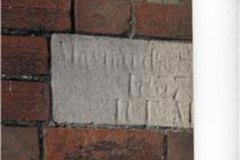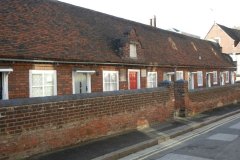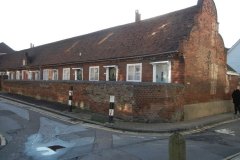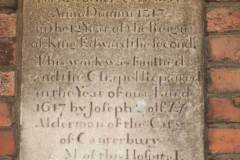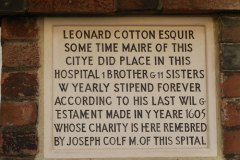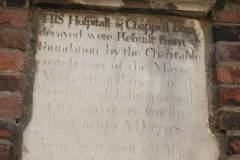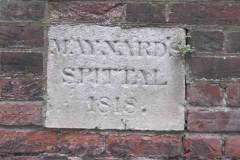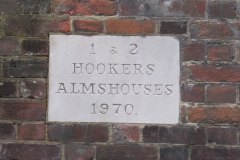Hospital Lane off Castle Street
These almshouses were originally founded in the 12th century by a wealthy citizen called Maynier the Rich. At that time the hospital, or ‘Spital’ as it was called, was to house the elderly poor, (not those in need of medical attention) 3 men and 4 women. In 1604 three further dwellings were provided for one poor widower and two poor widows under the will of the mayor, Leonard Cotton. It was a requirement that they be drawn from the local parishes of St Margaret’s or St Mildred’s.
There is a plaque (Image 1) in Rosemary Lane recording the limit of the hospital’s land and it is likely that the lane takes its name from the herbs that were grown on this plot; the hospital seems to have owned the whole block from Castle Street down to Stour Street.
Little is known of the medieval history as the archives were in London as part of a legal battle and they were lost in the Great London Fire of 1666. Further ill-fortune struck the almshouses themselves when the great storm of 1703, which damaged so many buildings in England, also damaged them. The single storey houses that you see today date from the re-building of 1708 (Images 2 and 3). The charming chapel is perhaps the most interesting part of the almshouses. It is wood-panelled and the residents sit facing one another; a wooden candelabra lights the small chapel at night but during the day there is a large south facing window for light. The coat of arms of Queen Anne is over the door.
In 1970 the May Hooker extension provided a further two bungalows to the rear of the old almshouses. Through subsequent modernisation, all the residents now have houses to today’s standards.
What to see:
- The plaque in Rosemary Lane – very difficult to read in direct sun light but it seems to be ‘Maynard 1837’
- External plaques, including those over and to either side of the door to Hospital Lane, recording the history of the building (Images 4-8)
Access: Private property but can be viewed from Hospital Lane and Stour Street.
Sources: Hasted (1800); Ingram Hill (2004)
AT

